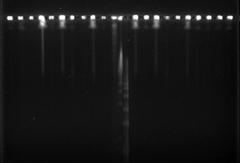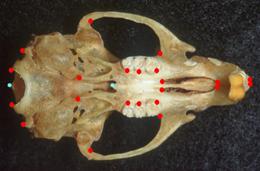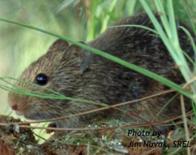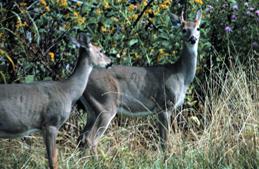Evolutionary Toxicology
 Dr. Novak has been investigating the
effect of contaminants on the integrity of DNA at several sites such as
the LCP superfund site in Brunswick , GA (PCB's and Metals) and the
Savannah River Site near Aiken, SC (Radionuclides and Metals). He
utilizes PFGE to estimate double stranded breaks in DNA. He will be
extending his assays to investigate the effects of strand breakage to
evolutionary dynamics of populations.
Dr. Novak has been investigating the
effect of contaminants on the integrity of DNA at several sites such as
the LCP superfund site in Brunswick , GA (PCB's and Metals) and the
Savannah River Site near Aiken, SC (Radionuclides and Metals). He
utilizes PFGE to estimate double stranded breaks in DNA. He will be
extending his assays to investigate the effects of strand breakage to
evolutionary dynamics of populations.
Selected
Publications
- Murray, S.M., K.F. Gaines, J. M. Novak, M. Gochfeld, and J. Burger. 2010. DNA double-strand breakage as an endpoint to examine Ni and U exposure effects to watersnakes on a nuclear industrial site. Human Ecol. Risk Assess. 16:282- 300.
- Gaines K.F., and J. M. Novak. 2008. Raccoon (Procyon lotor) harvesting on and near the Department of Energy’s Savannah River Site: Utility of metapopulation modeling for prediction and management of hunter risk? In R. Akcakaya, J. D. Stark and T. S. Bridges (eds). Demographic Toxicity: Methods in Ecological Risk Assessment. Oxford University Press, Oxford, England, UK.
- J.C. Cumbee, Jr., K.F. Gaines, G.L. Mills, W.L. Stephens, Jr., J. M. Novak, I.L. Brisbin, Jr.. 2008. Clapper Rails as indicators of mercury and PCB trophic transfer in a Georgia saltmarsh system. Ecotoxicology. 17:485-494
- Novak J. M., K.F. Gaines, J.C. Cumbee, Jr., G.L. Mills, A. Rodrigues-Navarro and C.S. Romanek. 2006. Clapper Rails as indicator species of estuarine marsh health. Studies In Avian Biology 32:270-281.
- Burger, J., S. Murray, K.F. Gaines, J. M. Novak, T. Punshon, C. Dixon and M. Gochfeld. 2006. Element levels in snakes in South Carolina: Differences between a contaminated and a reference site on the Savannah River Site. Environmental Monitoring and Assessment 112:35-52.
- Staub, B.P., W.A. Hopkins, J. M. Novak, J.D. Congdon. 2004. Respiratory and reproductive characteristics of eastern mosquitofish (Gambusia holbrooki) inhabiting a coal ash settling basin. Arch. Environ. Contam. Toxicol. 46:96-101.
Organismal Form
 Dr. Novak has been
using geometric morphometrics to investigate the evolution of form
(Size, Shape and Symmetry) in organisms. Extensions to the statistical
estimation of components have also been investigated. Individual form
components are also utilized as endpoints for ecotoxicological studies
as well as management endpoints for wildlife and endangered species.
Current projects focus on white-tailed deer, hispid cotton rats and
red-eared sliders. Future projects will involve determining the genetic
basis of form using a model organism.
Dr. Novak has been
using geometric morphometrics to investigate the evolution of form
(Size, Shape and Symmetry) in organisms. Extensions to the statistical
estimation of components have also been investigated. Individual form
components are also utilized as endpoints for ecotoxicological studies
as well as management endpoints for wildlife and endangered species.
Current projects focus on white-tailed deer, hispid cotton rats and
red-eared sliders. Future projects will involve determining the genetic
basis of form using a model organism.
Selected Publications
- Collyer, M.C., J. M. Novak, and C.A. Stockwell. 2005. Morphological divergence in recently established populations of White Sands pupfish (Cyprinodon Tularosa). Copeia 2005:1-11.
- Oleksyk, T.K., J. M. Novak, J.R. Purdue, S.P. Gashchak and M.H. Smith. 2004. High levels of fluctuating asymmetry in populations of Apodemus flavicollis from the most contaminated areas in Chornobyl. J. Environmental Radioactivity 73:1-20. (http://authors.elsevier.com/sd/article/S0265931X03002224)
- Smith, M.H., J. M. Novak, T.K. Oleksyk, J.R. Purdue, and S.P. Gashchak. 2002. Fluctuating Asymmetry of Shape in Rodents from Radioactively Contaminated Environments at Chornobyl. In: Scientific and Technical Aspects of Chornobyl. Collection of Scientific Articles. Eds. V. Glygalo and A. Nosovsky. Slavutich, Ukraine: POLYTECHNIKA, 4:492‐503.
- Oleksyk, T.K., M.H. Smith, S.P. Gashchak, J. M. Novak, and J.R. Purdue. 2002. Problems with developmental stability in two rodent species from Chornobyl. Radioprotection‐Colloques, 37(C1):859‐864.
- Mayer, J.J., J. M. Novak and I.L. Brisbin, Jr. 1998. Evaluation of Molar Size as a Basis for Distinguishing Wild Boar from Domestic Swine: Employing the Present to Decipher the Past. MASCA Research Papers in Science and Archaeology 15: 39 – 53.
- Novak, J.M. , O.E. Rhodes, Jr., M.H. Smith and R.K. Chesser. 1993. Morphological asymmetry in mammals: Genetics and homeostasis reconsidered. Acta Theriologica 38:7-18.
- Lamb, T., J. M. Novak and D.L. Mahoney. 1990. Morphological asymmetry and interspecific hybridization: a case study using hylid frogs. J. Evol. Biol. 3:295- 309.
Ecological and Quantitative Genetics
 Dr. Novak uses the methodology of
ecological and quantitative genetics in his research. This allows for a
more realistic approach to studying populations of organisms since it
allows variation to be assessed for both genetic and environmental
variables.
Dr. Novak uses the methodology of
ecological and quantitative genetics in his research. This allows for a
more realistic approach to studying populations of organisms since it
allows variation to be assessed for both genetic and environmental
variables.
Selected Publications
- Smith, M.H., J. M. Novak, J.D. Peles and J.R. Purdue. 2001. Genetic heterogeneity of white-tailed deer: management lessons from a long-term study. Mamm. Biol. 66:1-12.
- Serfass, T.L., R.P. Brooks, J. M. Novak, P.E. Johns, and O.E. Rhodes, Jr. 1998. Genetic Variation Among Populations of River Otters in North America: Considerations For Reintroduction Projects. J. Mammalogy 79:736-746.
- Hernandez-Martich, J.D., J. M. Novak, M.H. Smith and P.E. Johns. 1995. Genetic structure of mosquitofish populations in the Altamaha and Ogeechee drainages of Georgia: reporting an undescribed form in the Ocmulgee River. Biochemical Systematics and Ecology 23:617-625.
- Chesser, R.K., D.W. Sugg, O.E. Rhodes, Jr., J. M. Novak and M.H. Smith. 1993. Evolution of mammalian social organization. Acta Theriologica 38:163-174.
- McDonald, M.M., M.H. Smith, M.W. Smith, J. M. Novak, P.E. Johns and A.L DeVries. 1992. Biochemical systematics of notothenioid fishes from Antarctica. Biochem. Syst. Ecol. 20:233-241.
- Teska, W.R., M.H. Smith and J. M. Novak. 1990. Effects of food quality and heterozygosity upon fitness of Peromyscus polionotus. Evolution 44:1318- 1325.
- Novak, J.M., L.M. Smith and L.D. Vangilder. 1989. Genetic variability within and among wintering populations of brant. J. Heredity. 80:160-163.
- Hepp, G.R., J. M. Novak, K.T. Scribner and P.W. Stangel.1 1988. Genetic distance and hybridization of black ducks and mallards: A morph of a different color? The Auk 105:804-807.
- Order of authors alphabetical
Wildlife Ecology and Management
 Dr. Novak uses his expertise to promote
the management of wildlife and endangered species within an
evolutionary context that is conducive to the implementation of
adaptive management protocols. In addition, he promotes the idea that
wildlife must be managed within the context of human disturbance of
ecosystems, including the impact of toxicants. Most past research has
focused on mammals such as white-tailed deer, river otters and raccoons.
Dr. Novak uses his expertise to promote
the management of wildlife and endangered species within an
evolutionary context that is conducive to the implementation of
adaptive management protocols. In addition, he promotes the idea that
wildlife must be managed within the context of human disturbance of
ecosystems, including the impact of toxicants. Most past research has
focused on mammals such as white-tailed deer, river otters and raccoons.
Selected Publications
- DeMots, R.L., J. M. Novak, K.F. Gaines, A.J. Gregor, C.S. Romanek and D.A. Soluk. 2010. Tissue-diet discrimination factors and turnover of stable carbon and nitrogen isotopes in white-footed mice (Peromyscus leucopus). Can. J. Zool. 88:961-967.
- Warrner, S.S., A.M. Holtrop, L.C. Hinz, Jr., J. M. Novak and R.U. Fischer. 2010. Evaluating the Illinois Stream Valley Segment Model as an Effective Management Tool. Environ. Manage. 46:761-770.
- Rhodes, O.E. Jr., J. M. Novak, M.H. Smith and P.E. Johns. 1991. Frequency distribution of conception dates in a whitetailed deer herd. Acta Theriol. 36:131-140.
- Novak, J.M., K.T. Scribner, W.D. Dupont and M.H. Smith. 1991. Catch-effort estimation of white-tailed deer population size. J. Wildl. Manage. 55:31-38.
- Rhodes, O.E. Jr., J. M. Novak, M.H. Smith and P.E. Johns. 1986. Assessment of fawn breeding in a South Carolina deer herd. Proc. Ann. Conf. SE. Assoc. Fish Wildl. Agencies. 40:430-437
- Novak, J.M. 1983. Multiple captures of Peromyscus leucopus: social behavior in a small rodent. J. Mammal. 64:710- 713.
- Applegate, R.D., L.L. Rogers, D.A. Casteel and J. M. Novak. 1979. Germination of cow parsnip seeds from grizzly bear feces. J. Mammal. 60:655.
- Novak, J.M. 1978. Distribution and relative abundance of small mammals in the Illini Forest Plantation, Urbana, Illinois. For. Res. Rpt. No. 78(11):1-5.
 James
M.
Novak
James
M.
Novak